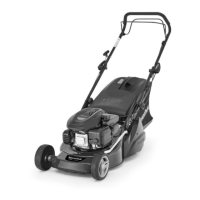8
1.3 Battery connection (if present)
• Electric key ignition models
Connect the battery cable to the general wiring connector on the lawn-
mower.
• Electric push-button ignition models
Insert the supplied battery in the relative engine compartment (par.
2. CONTROL DESCRIPTION
NOTE - The meaning of the symbols on controls are explained in
the previous pages.
2.1 Throttle
The throttle is controlled by the lever (1) and positioned as shown on the
of a throttle.
2.2 Blade brake
The blade brake is controlled by the lever (1) which must be held against
the handle for ignition and during lawnmower operations.
The engine stops when the lever is released.
IMPORTANT - The blade must stop within a few seconds of when
the lever is released; if you notice that more time is required for it to
stop, contact a Mounteld Authorised Service Dealer immediately.
2.3 Drive lever (if provided)
On power-driven models, pull the lever (1) against the handle for forward
movement.
The lawnmower stops moving forward when the lever is released.
.
2.4 Cutting height adjustment
3. GRASS CUTTING
3.1 Fastening the grass-catcher
Lift the stone-guard and fasten the grass-catcher (1) correctly as shown
in the illustration.
3.2 Engine ignition
During ignition, follow the instructions in the engine manual.
3.2a
• Manual ignition models (“I”)
on the ignition cable (2).
• Electric key ignition models
3.2b
• Electric push-button ignition models (“III - “IV”)
(follow the instructions provided in the engine manual).
NOTE Keep pulling the engine / blade brake lever or the engine will
stop.
3.3 Grass cutting
The appearance of the lawn will improve if you alternate cutting in both
directions at the same height.
• Grass-catcher full warning indicator (if applicable): whilst working,
with the blade in motion, the indicator remains lifted as long as the
grass-catcher is able to hold cut grass; when it lowers, it means that the
grass-catcher is full and it must be emptied.
3.4 Emptying the grass-catcher
the sound of the lawnmower changes and the grass-catcher is no longer
To remove and empty the grass-catcher,
– stop the engine and wait for the blade to stop;
– lift the stone-guard, grasp the handle and remove the grass-catcher
keeping it in tilted position.
3.5 When work is finished
When work has been completed, release the brake lever (1) and discon-
nect the spark plug cap (2).
• Electric key ignition models
• Electric push-button ignition models
further.
3.6 Lawn care recommendation
ways to care for the lawn; always read the instructions on seed boxes for
mowing height for the growth conditions in the work area.
Keep in mind that the most grass is made up of a stem and one or more lea-
The following indications generally apply:
• in the summer, cutting must be higher to avoid the ground from drying;
grass and tear the lawn;
• for particularly high grass, initially mow at maximum admitted machine
height followed by a second mow after two or three days.
4. ROUTINE MAINTENANCE
IMPORTANT - Routine and accurate maintenance is essential in
maintaining original machine safety and performance levels.
Each adjustment or maintenance operation must be done with the engine
stopped, after removing the spark plug cap.
Store the lawnmower in a dry place.
1) Wear sturdy work gloves before cleaning, maintaining or adjusting the
machine.
2) Wash the machine with water after each mowing, remove grass debris
and mud accumulated under the chassis to prevent it from drying and
causing problems the next time the lawnmower is used.
select the lowest cutting height and always stand behind the lawnmower
handle when cleaning
the abrasive action of the cut grass; in this case, touch up the paintwork
using a rustproof paint to prevent the formation of rust that would lead
to corrosion of the metal .
5) If accessing the lower part is necessary, only tilt the machine on the
side indicated in the engine manual, following the relevant instructions.
Do not drip petrol onto the plastic parts of the engine or the machine to
prevent damaging them and remove all traces of spilt petrol immediately.
The warranty does not cover damage to plastic parts caused by petrol.

